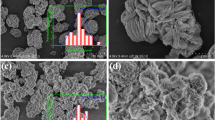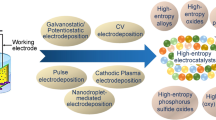Abstract
The phase structure of palladium–bismuth binary electrolytic deposit was studied. The electrodeposition of deposit components on the surface of a graphite electrode (GE) was carried out in situ. On current–voltage curves, the peak of bismuth electrooxidation, the peak of palladium electrooxidation and an additional peak at 0.15 V vs. Ag/AgCl are observed. The peak current at 0.15 V depends both on the concentration of palladium(II) ions and on that of bismuth(III) ions. The thermodynamic theory of alloys in the approximation of the theory of regular solutions was used for calculations. The mixing heat of the binary alloy components and the equilibrium potential of bismuth in the bismuth–palladium alloy are calculated. The calculated equilibrium potential of bismuth in an alloy with palladium is 0.12 V vs. Ag/AgCl which corresponds to the Bi2Pd intermetallic compound (IMC). Investigation of the surface of a GE with a palladium–bismuth deposit with use of scanning electron microscope showed that the electrolytic deposit contains bismuth, palladium and the Bi2Pd IMC. Peak at the potential of plus 0.15 V vs. Ag/AgCl is due to selective bismuth electrooxidation from the Bi2Pd IMC.






Similar content being viewed by others
References
Budnikov GK, Evtyugin GA, Maystrenko VN (2010) Modified electrodes for voltammetry in chemistry, biology and medicine. Binom, Moscow
Noskova GN, Zakharova EA (2012) Properties and application of gold-carbon composite electrodes in electrochemical analysis methods. Bulletin of TPU 3:109–115
Hamburg JD (1997) Electrochemical crystallization of metals and alloys. Janus-K, Moscow
Shekhovtsova NS, Glyzina TS, Romanenko SV, Kolpakova NA (2012) Estimation of the composition of electrolytically prepared intermetallic bismuth-platinum deposits. J Solid State Electrochem 16(7):2419–2423
Marshakov IK, Vvedensky AV, Kondrashin VY, Bokov GA (1988) Anodic dissolution and selective corrosion of alloys. Voronezh University, Voronezh
Marshakov IK (2000) Selective corrosion of alloys. SOJ 6(4):57–62
Anastasopoulos A, Hayden BE (2015) Bismuth palladium based catalyst for a fuel cell with a molecular hydrogen source. US Patent 9190671
Francis J, Francis Jr, Hector D (2004) Intermetallic compounds for use as catalysts and catalytic systems. US Patent 012290
Milhano C, Pletcher D (2008) The electrodeposition and electrocatalytic properties of copper–palladium alloys. J Electroanal Chem 1:24–30
Nadezhina LS, Lobanova OA, Pankina IA (1998) J Anal Chem 53(2):151–153
Andreev YA (2016) Electrochemistry of metals and alloys. Higher Education and Science, Moscow
Tyurin AG (2004) Thermodynamics of chemical and electrochemical stability of alloys: studies. Chelyabinsk State University, Chelyabinsk
Kozin LF, Nigmetova RS, Dergacheva MB (1977) Thermodynamics of binary amalgam systems. Science, Moscow
Sryvalin IT, Esin OA, Vitolin IA, Lepinsky BM, Korpachev VG (1969) Physical chemistry of metallurgical melts. Proceedings of the Institute of Metallurgy, Sverdlovsk
Tyurin AG (2005) Generalized theory of “regular” solutions. XV International Conference on Chemical Thermodynamics in Russia: abstracts. Moscow State. University Press, Moscow
Brainina KZ, Neiman EY (1982) Stripping electroanalytical methods. Chemistry, Moscow
Glyzina ТS (2009) Electrochemical behavior of bismuth on mercury and graphite electrodes modified with gold and platinum and its determination by methods of voltammetry in gold ore mineral raw: dissertation for candidate degree on chemical sciences. Tomsk Polytechnic University, Tomsk
Gorchakov EV (2008) Stripping-voltammetric determination of gold and palladium in gold mineral raw: dissertation for candidate degree on chemical sciences. Tomsk Polytechnic University, Tomsk
Vol AE, Kagan IK (1979) The structure and properties of binary metal systems. Science, Moscow
Semerano J, Vianello E (1959) Research in the field of oscillographic polarography with a linear character of voltage polarization. VII Mendeleev Congress on General and Applied Chemistry: Reports of Foreign Scientists. Science, Moscow
Zakharov MS (2006) Methods of research of electrode processes in electroplating. Publishing House of TSOGU, Tyumen
Brief chemical encyclopedia (1963) In: Knunyants IL (ed) Soviet Encyclopedia, vol 2, Moscow, p 1021
Kondratiev VN (ed) (1974) The energy of rupture of chemical bonds. Potentials of ionization and electron affinity. Science, Moscow
Pauling L, Pauling P (1978) Chemistry. Mir, Moscow
Sukhotin AM (1981) Handbook of Electrochemistry. Chemistry, Leningrad
Cherkasov N, Ibhadon AO, McCue A, Anderson JA, Johnston SK (2016) Palladium-bismuth intermetallic and surface-poisoned catalysts for the semi-hydrogenation of 2-methyl-3-butyn-2-ol. Appl Catal A Gen. https://doi.org/10.1016/j.apcata.2015.02.038
Dechong M, Jingzhe Z et al (2012) Synthesis of bismuth nanoparticles and self-assembled nanobelts by a simple aqueous route in basic solution. Colloids Surf A 395:276–283
Lan Y, Luo H, Ren X, Wang Y, Liu Y (2012) Anodic stripping voltammetric determination of arsenic (III) using a glassy carbon electrode modified with gold-palladium bimetallic nanoparticles. Microchim Acta 178(1–2):153–161
Okamoto H (1994) The Bi-Pd (bismuth-palladium) system. J Phase Equilib 2:191–194
Rezaein B, Shams-Ghahfarokhi L, Havakeshian E, Ensafi A (2016) An electrochemical biosensor based on nanoporous stainless steel modified by gold and palladium nanoparticles for simultaneous determination of levodopa and uric acid. Talanta 158:42–50
Zalineeva A, Martinez U, Serov A, Baranton S, Coutanceau C, Atanassov P (2013) Pd-Bi catalysts for electrooxidation of alcohols. Abstract, San Francisco
Acknowledgements
The authors are grateful to the director of the Innovation Centre “Gold and Platinum” Pshenichkin A.Y., Ph.D., and Rudmin M.A., Ph.D., for the provision of scientific equipment, assistance, and support.
Funding
This work was supported by the framework of Tomsk Polytechnic University Competitiveness Enhancement Program grant.
Author information
Authors and Affiliations
Corresponding author
Rights and permissions
About this article
Cite this article
Sabitova, Z.K., Oskina, Y.A. & Kolpakova, N.A. Study of electrooxidation of binary electrolytic deposit palladium–bismuth deposited on graphite electrode surface. J Solid State Electrochem 22, 3717–3723 (2018). https://doi.org/10.1007/s10008-018-4084-y
Received:
Revised:
Accepted:
Published:
Issue Date:
DOI: https://doi.org/10.1007/s10008-018-4084-y




